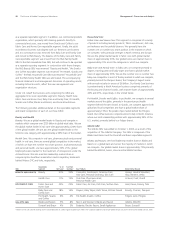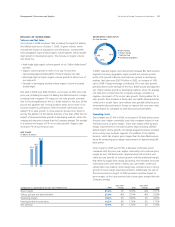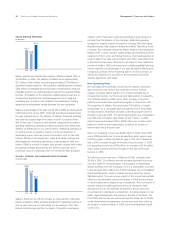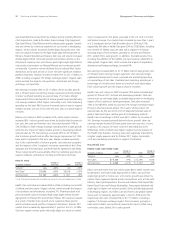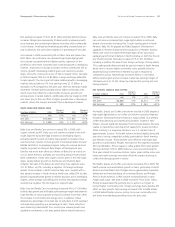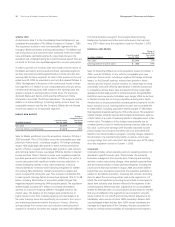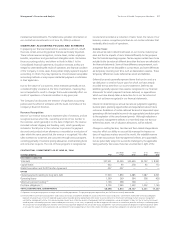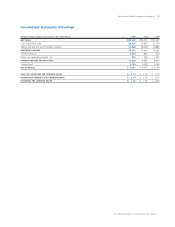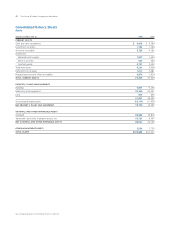Proctor and Gamble 2006 Annual Report Download - page 38
Download and view the complete annual report
Please find page 38 of the 2006 Proctor and Gamble annual report below. You can navigate through the pages in the report by either clicking on the pages listed below, or by using the keyword search tool below to find specific information within the annual report.
The Procter &Gamble Company and Subsidiaries
36 Management’s Discussion and Analysis
Capital Spending. We view capital spending efficiency as a critical
component of our overall cash management strategy. Capital expenditures
in 2006 were $2.67 billion, compared to $2.18 billion in 2005 and
$2.02 billion in 2004. The increase was largely driven by the addition
of the Gillette business. Capital spending was 3.9% of net sales, in
line with the prior year level.
CAPITAL SPENDING
(% of net sales)
05
3.8
04
3.9
03
3.4
02
4.2
06
Proceeds from Asset Sales. Proceeds from asset sales in 2006 were
$882 million primarily due to the divestitures of Spinbrush, Rembrandt
and Right Guard, all required by regulatory authorities in relation to
the Gillette acquisition, and our Korea paper businesses. In 2005,
proceeds from asset sales were $517 million primarily due to the
divestiture of the Juice business in August of 2004.
Financing Activities
Dividend Payments. Our first discretionary use of cash is dividend
payments. Dividends per common share increased 12% to $1.15 per
share in 2006. This increase represents the 50th consecutive fiscal year
the Company has increased its common share dividend. Total dividend
payments to both common and preferred shareholders were $3.70 billion,
$2.73 billion and $2.54 billion in 2006, 2005 and 2004, respectively.
DIVIDENDS
(per common share)
05
1.03
04
0.93
03
0.82
02
0.76
06
Long-Term and Short-Term Debt. We maintain debt levels we
consider appropriate after evaluating a number of factors, including
cash flow expectations, cash requirements for ongoing operations,
investment plans (including acquisitions and share repurchase activities)
and the overall cost of capital. Total debt was $38.10 billion in 2006,
$24.33 billion in 2005 and $20.84 billion in 2004. The increase in
debt in 2006 and in 2005 was primarily due to additional debt used
to finance the share repurchase program announced in conjunction
with the Gillette acquisition.
Liquidity. Our primary source of liquidity is cash generated from
operations. We believe internally generated cash flows adequately
support business operations, capital expenditures and shareholder
dividends, as well as a level of other discretionary cash uses (e.g., for
minor acquisitions or share repurchase).
We are able to supplement our short-term liquidity, if necessary, with
broad access to capital markets and four bank credit facilities. Broad
access to financing includes commercial paper programs in multiple
markets at favorable rates given our strong credit ratings (including
separate U.S. dollar and euro multi-currency programs).
We maintain two bank credit facilities: a $1 billion, five-year facility
which matures in July 2007 and a $1 billion, five-year facility which
matures in July 2009. We have never drawn against either facility and
have no plans to do so in the foreseeable future. On July 27, 2005,
we also signed a $24 billion three-year credit facility with a syndicate
of banks. The credit facility is available for general corporate purposes
but was primarily established to fund the share buyback plan
announced concurrently with the Company’s acquisition of Gillette.
We also assumed a $1.8 billion, five-year facility from the Gillette
acquisition that matures in August 2010.
These credit facilities do not have cross-default or ratings triggers,
nor do they have material adverse events clauses, except at the time
of signing. While not considered material to the overall financial
condition of the Company, there is a covenant in the credit facilities
stating the ratio of net debt to earnings before interest expense,
income taxes, depreciation and amortization cannot exceed 4.0 at
the time of a draw on the facility. As of June 30, 2006, we are
comfortably below this level, with a ratio of approximately 1.9.
In addition to these credit facilities, long-term borrowing available
under our current shelf registration statement was $6.93 billion at
June 30, 2006.
The Company’s Moody’s and Standard &Poor’s (S&P) short-term
credit ratings are P-1 and A-1+, respectively. Our Moody’s and S&P
long-term credit ratings are Aa3 and AA- with a negative outlook,
respectively, due to the Gillette acquisition.
Treasury Purchases. During the past year, we substantially increased
our level of share repurchases. Total share repurchases in 2006 were
$16.9 billion, of which $16.8 billion were made as part of our publicly
announced share repurchase plan. In 2005, we repurchased $5.0
billion of shares, of which $3.0 billion were made as part of our
publicly announced share repurchase plan. We completed the
announced share buyback program in July 2006 and purchased a
total of $20.1 billion of shares under this program.
Guarantees and Other Off-Balance Sheet Arrangements. We do not
have guarantees or other off-balance sheet financing arrangements,
including variable interest entities, that we believe could have a
material impact on financial condition or liquidity.


